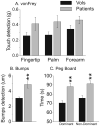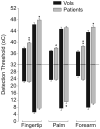Subclinical peripheral neuropathy is a common finding in colorectal cancer patients prior to chemotherapy
- PMID: 22496202
- PMCID: PMC3619440
- DOI: 10.1158/1078-0432.CCR-12-0205
Subclinical peripheral neuropathy is a common finding in colorectal cancer patients prior to chemotherapy
Abstract
Purpose: Of the numerous complications associated with cancer and cancer treatment, peripheral neuropathy is a deleterious and persistent patient complaint commonly attributed to chemotherapy. The present study investigated the occurrence of subclinical peripheral neuropathy in patients with colorectal cancer before the initiation of chemotherapy.
Experimental design: Fifty-two patients underwent extensive quantitative sensory testing (QST) before receiving chemotherapy. Changes in multiple functions of primary afferent fibers were assessed and compared with a group of healthy control subjects. Skin temperature, sensorimotor function, sharpness detection, and thermal detection were measured, as was touch detection, using both conventional (von Frey monofilaments) and novel (Bumps detection test) methodology.
Results: Patients had subclinical deficits, especially in sensorimotor function, detection of thermal stimuli, and touch detection that were present before the initiation of chemotherapy. The measured impairment in touch sensation was especially pronounced when using the Bumps detection test.
Conclusions: The patients with colorectal cancer in this study exhibited deficits in sensory function before undergoing chemotherapy treatment, implicating the disease itself as a contributing factor in chemotherapy-induced peripheral neuropathy. The widespread nature of the observed deficits further indicated that cancer is affecting multiple primary afferent subtypes. Specific to the finding of impaired touch sensation, results from this study highlight the use of newly used methodology, the Bumps detection test, as a sensitive and useful tool in the early detection of peripheral neuropathy.
Conflict of interest statement
The authors have no conflicts of interest to declare.
Figures





References
-
- Cerase A, Brindisi L, Lazzeretti L, Pepponi E, Venturi C. Lung cancer presenting with trigeminal neuropathy. Neurol Sci. 2011;32:927–31. - PubMed
-
- Malloy KA, Chigbu DI. Anterior temporal chordoid meningioma causing compressive optic neuropathy. Optom Vis Sci. 2011;88:645–51. - PubMed
-
- Koike H, Tanaka F, Sobue G. Paraneoplastic neuropathy: wide-ranging clinicopathological manifestations. Curr Opin Neurol. 2011;24:504–10. - PubMed
-
- Dispenzieri A. POEMS syndrome: 2011 update on diagnosis, risk-stratification, and management. Am J Hematol. 2011;86:591–601. - PubMed
Publication types
MeSH terms
Grants and funding
LinkOut - more resources
Full Text Sources
Medical

